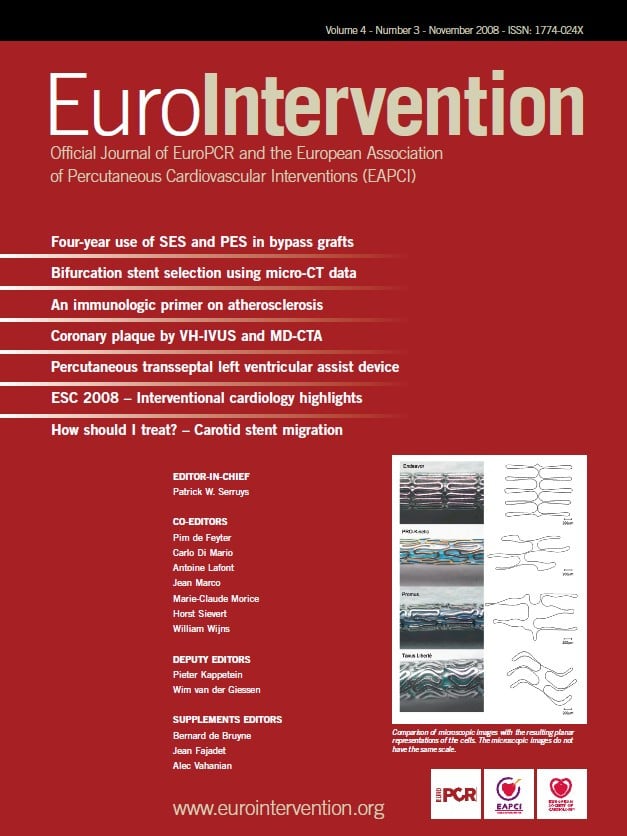Dear Colleagues,
The world is changing, and whether you think it is for better or worse, we believe that one lesson is amply clear: The more we learn to work together and integrate our energies, the surer our footing and the faster we advance. In some small way, this issue of EuroIntervention adheres to this, offering a range of opinions, research from Europe and throughout the world, as well as also marking the beginning of a closer cooperation – at least on a scientific/educational level – within our professional European organisations. Let’s begin examining this by looking at the content of our current edition.
The annual 2008 meeting of the European Society of Cardiology showed great interest in interventional techniques. Trials like SYNTAX and LEADERS were closely followed and our journal reviews these and other topics of interest from the ESC in the excellent Focus article/Highlights by Stefaan Van de Walle et al.
Continuing on an international front, this issue of EuroIntervention includes papers from outside of Europe. Chi-Hang Lee et al from Singapore looks at the “Long-term safety and efficacy... after implantation of Zotarolimus-Eluting Stent…” Another research article, this time from Iran, sees Danesh Sani et al studying the “Relationship between coronary and renal artery disease and associated risk factors in hypertensive and diabetic patients undergoing coronary angiography”.
Among the many papers of a more technical nature, we have one from Peter Mortier et al on the “Comparison of drug-eluting stent cell size using micro-CT: important data for bifurcation stent selection” which inaugurates the first in a mini-series to be published in upcoming issues of EIJ on bifurcation issues. We remind you, as always, to look to our evolving Internet presence for further information, archives and ahead-of-print articles on this, and all the subjects we touch on within the journal.
“How should I treat”, our “hands-on” case report – where invited experts comment on a chosen case before knowing the actual resolution – looks at a peripheral issue this time proposed by Castriota et al on “Stent migration as a late complication following carotid angioplasty and stenting”. Our invited experts are Marc van Sambeek and Eugenio Stabile.
In the spirit of integration and expansion of the educational opportunities afforded by this journal, and our meeting EuroPCR, “How Should I Treat” will not remain simply a mainstay of our print edition, but will be developed into an actual session at EuroPCR 09. We will be involved with 3 sessions at EuroPCR 09: the 2nd EuroIntervention Session, our “How Should I Treat Session” and additionally, we will be organising an outreach session for young and beginning authors on how to write a medical/scientific paper. Please see our website for further information on how to participate in any of these sessions, especially in terms of submissions of your papers, where the top six chosen by our editorial board for publication before February 25, 2009, will be chosen for presentation during the EIJ session itself.
To further advance European professional cooperation within our field, and on a personal note, I am pleased to announce my appointment as Deputy Editor of EuroHeart journal. Invited by our good friend and colleague, the newly named Editor-in-Chief of EuroHeart, Thomas Lüscher, my role – along with the other deputy editors - will be to facilitate the integration within the ESC of the various subspecialty journals, with the promise for future collaborations – similar to JACC and JACC-Intervention and CIRCULATION and CIRCULATION-Intervention.
We look forward to our future with your continued participation.

